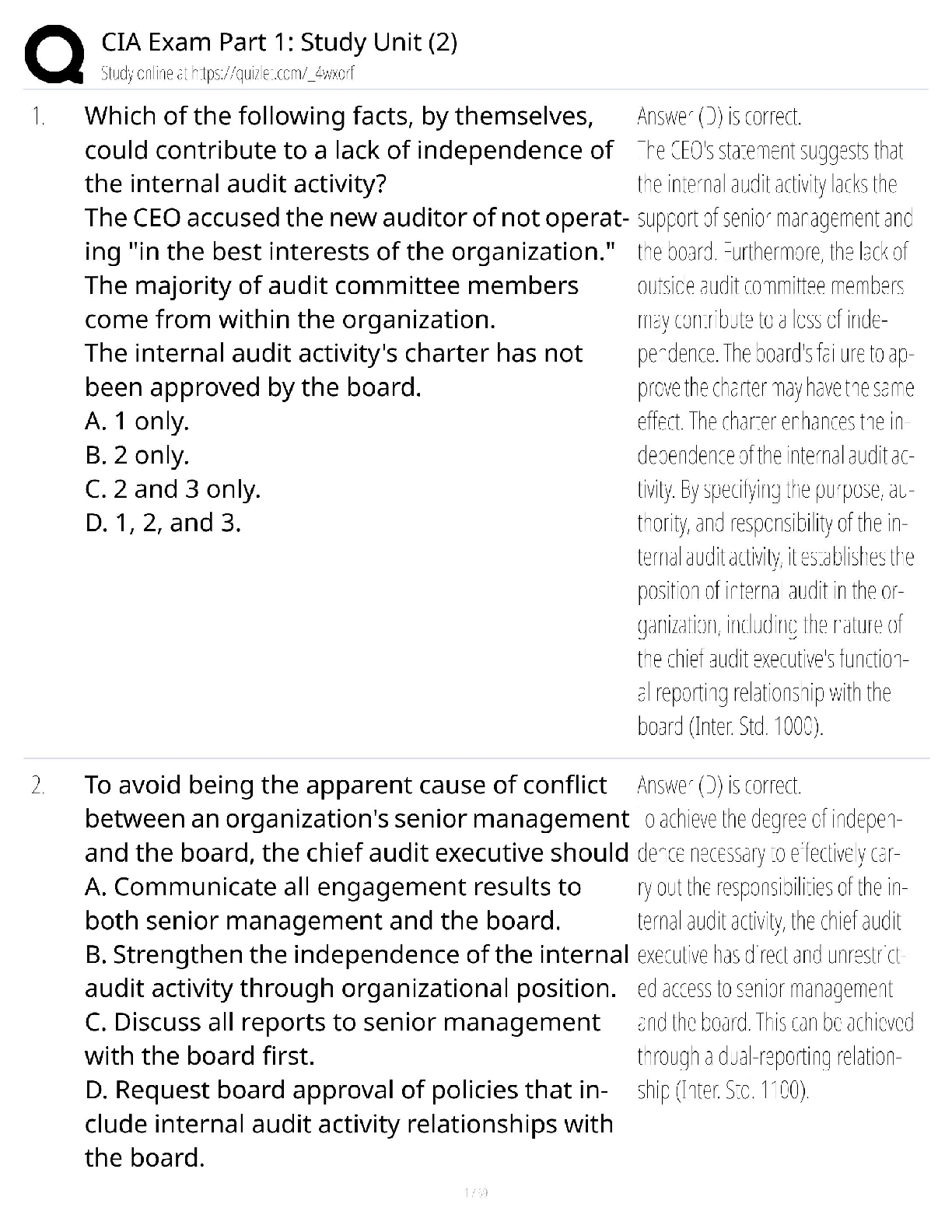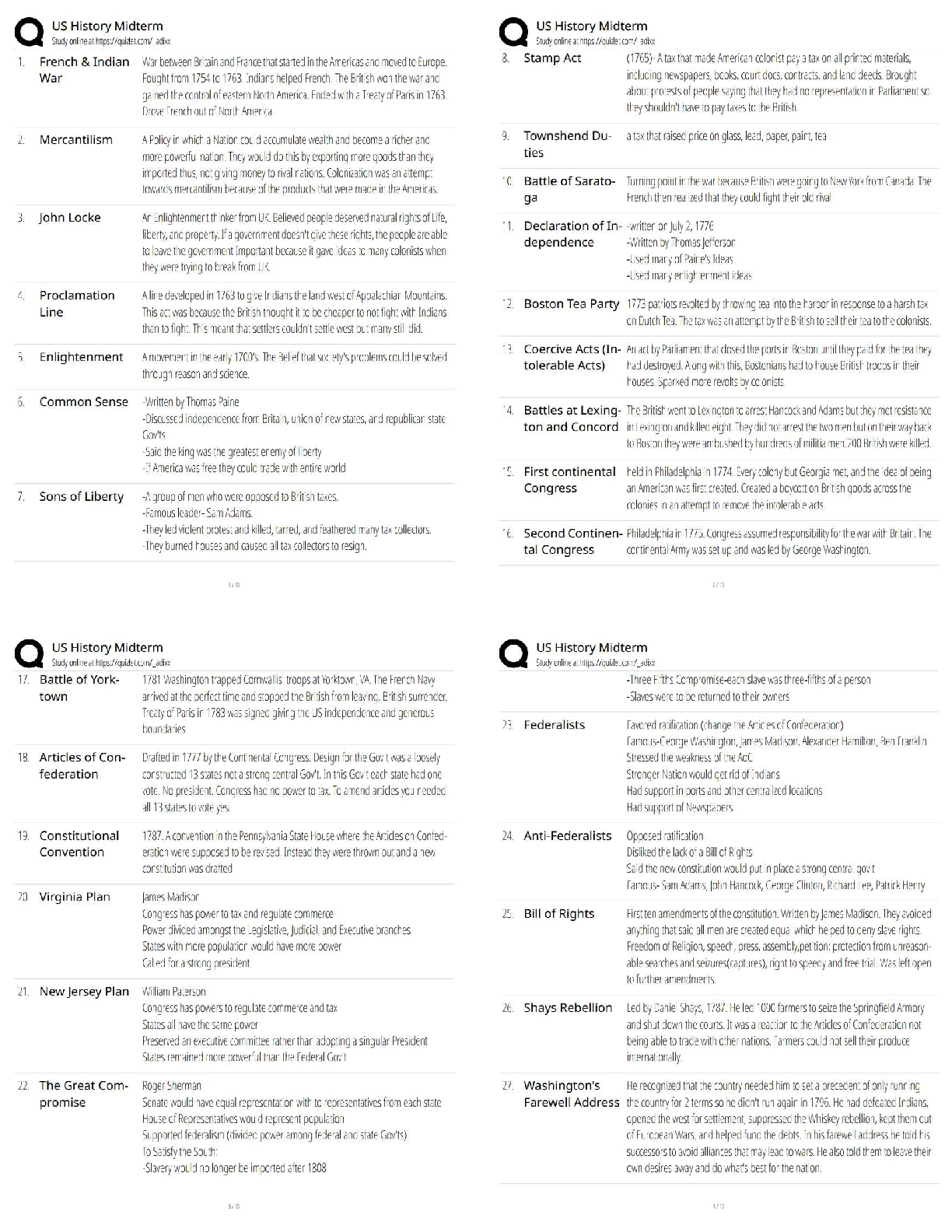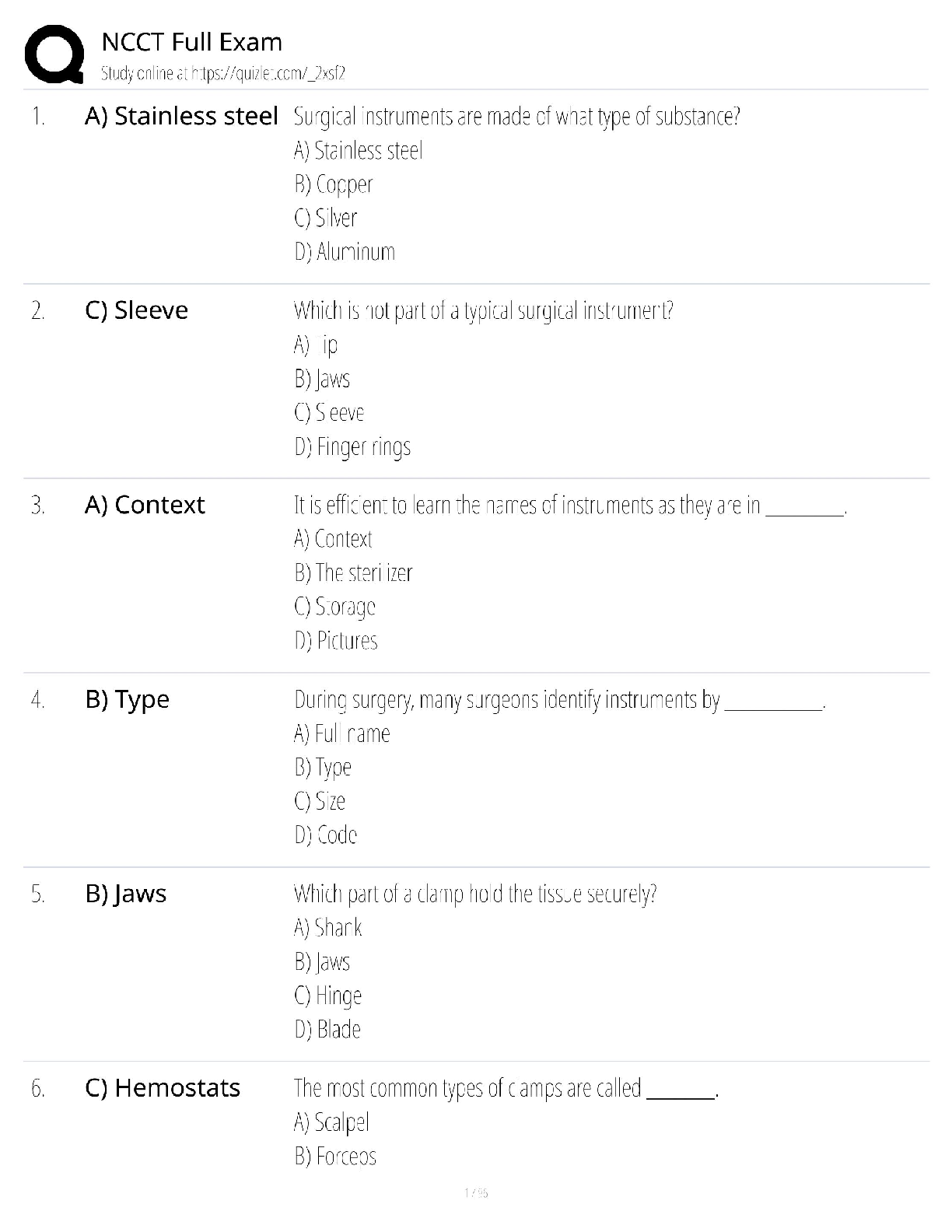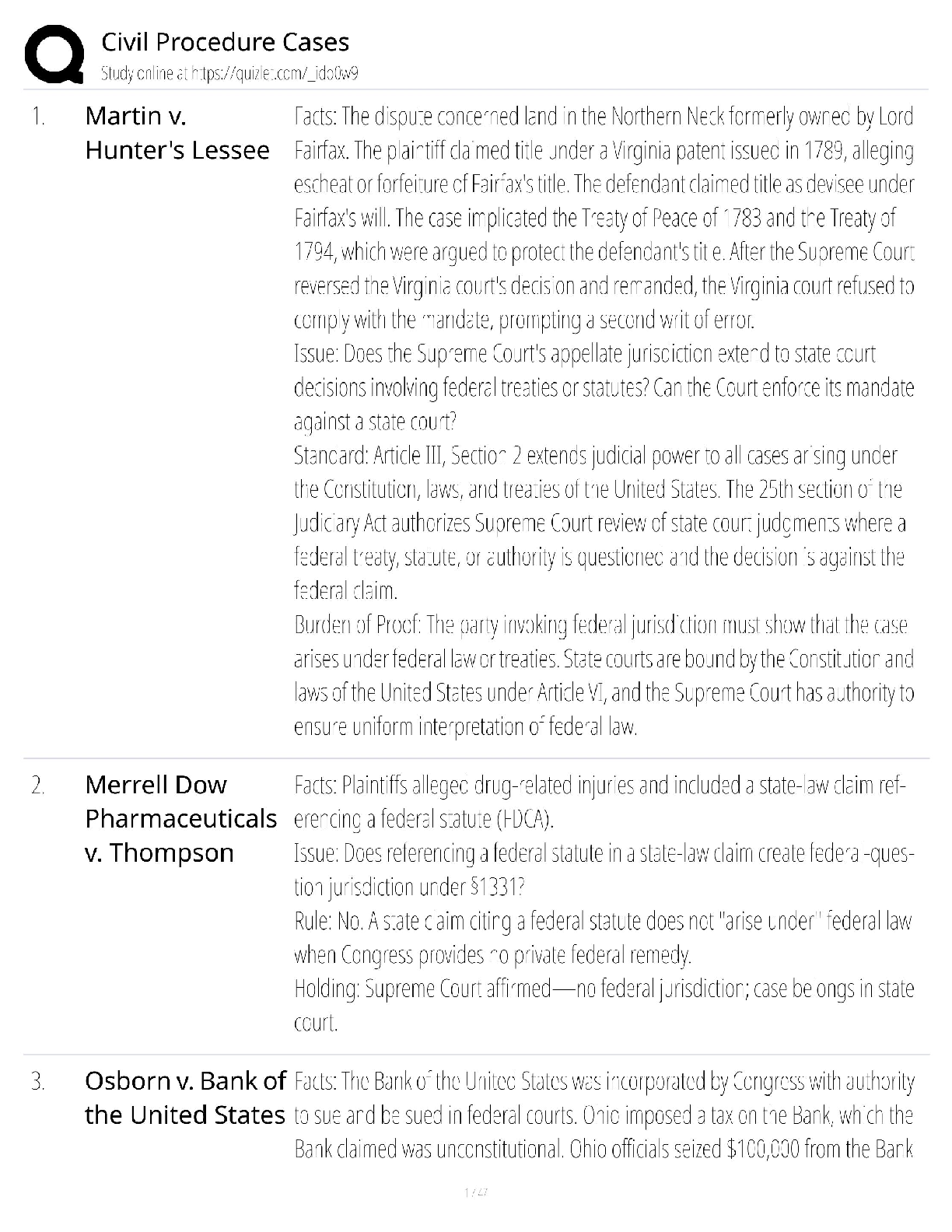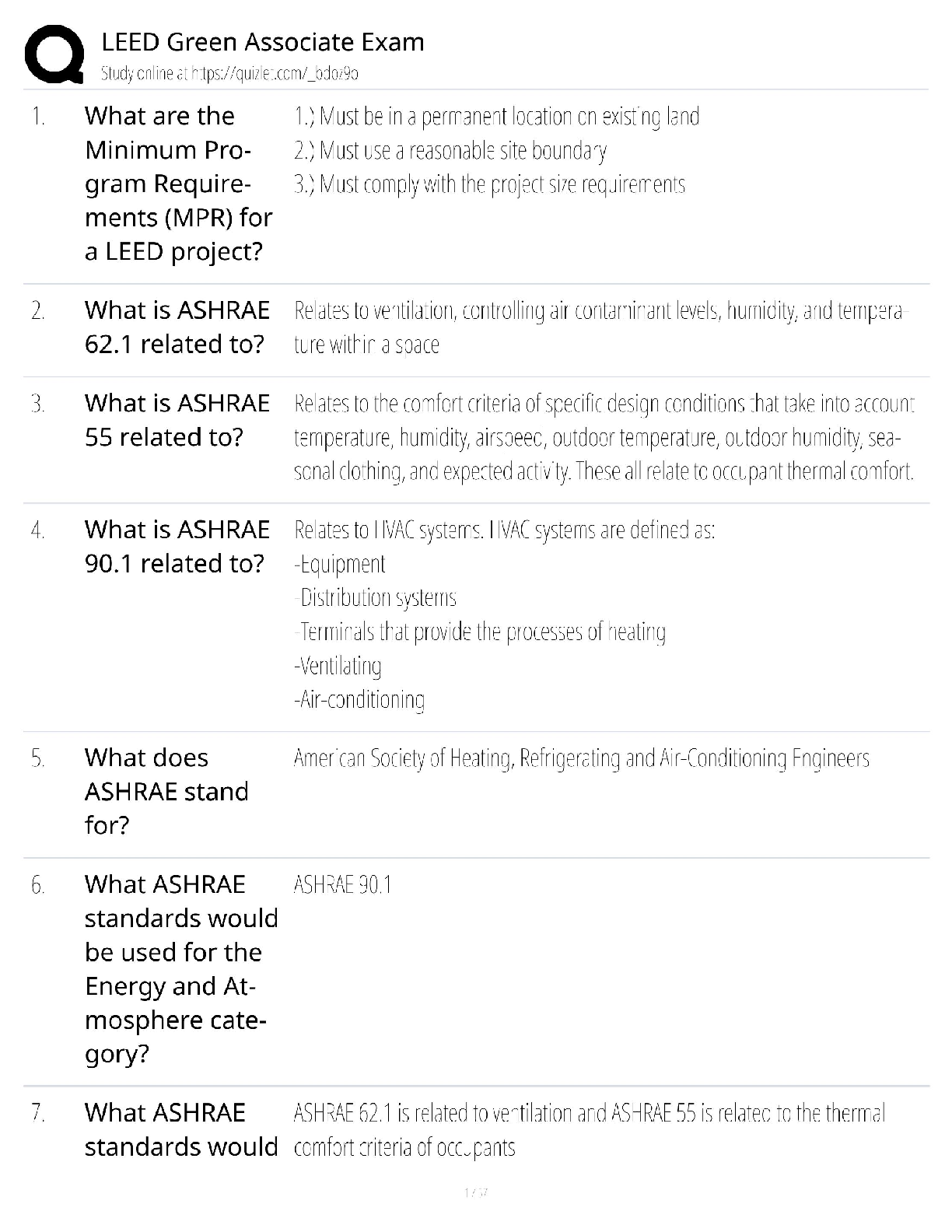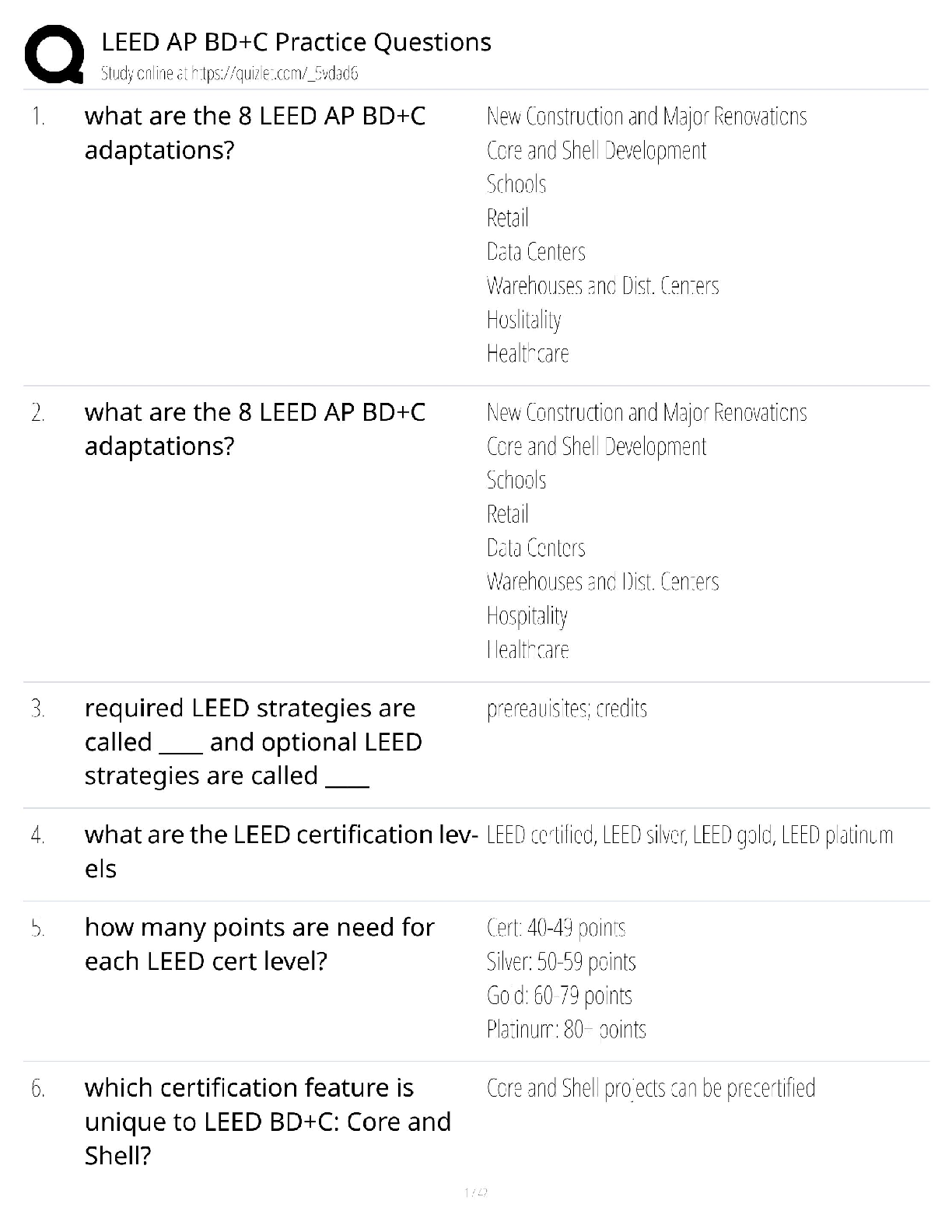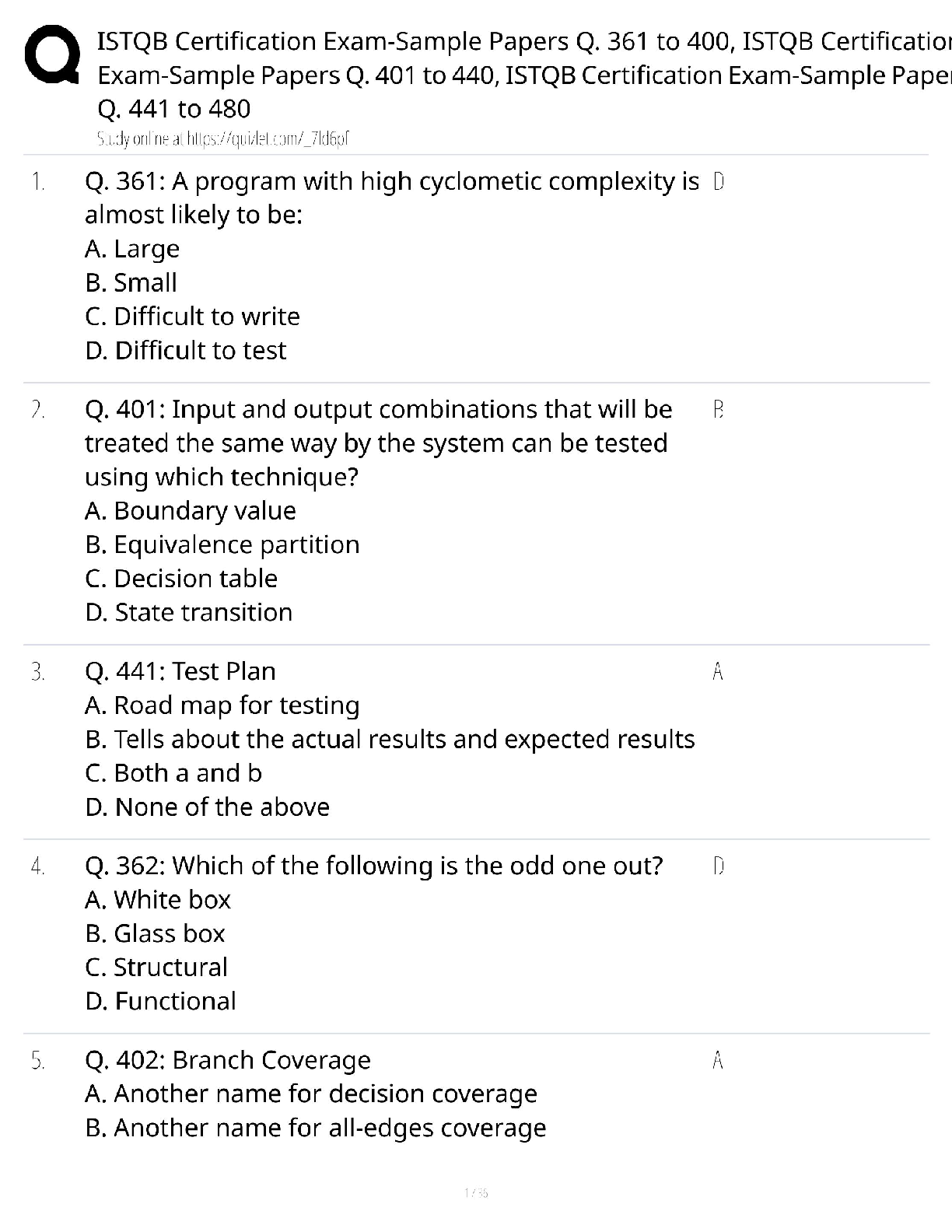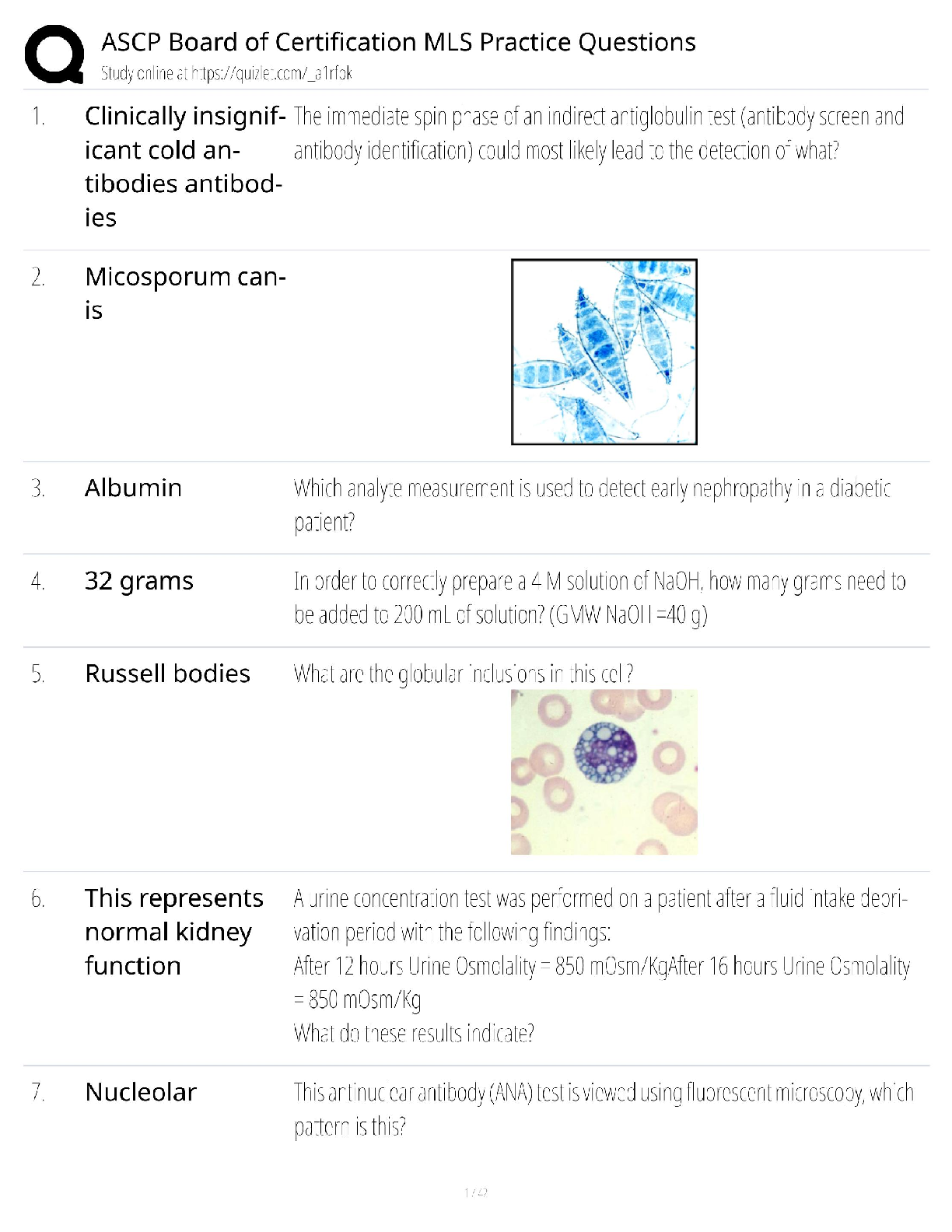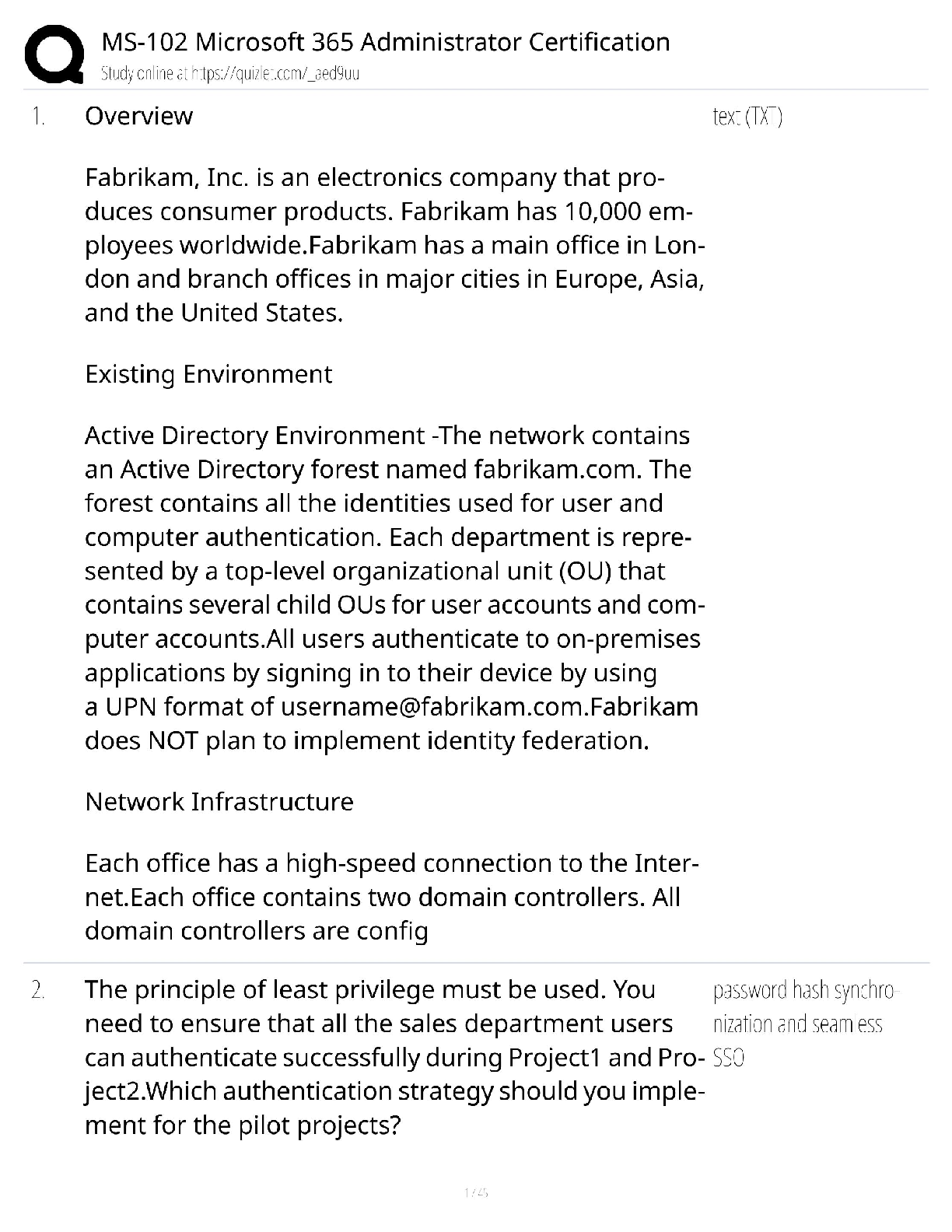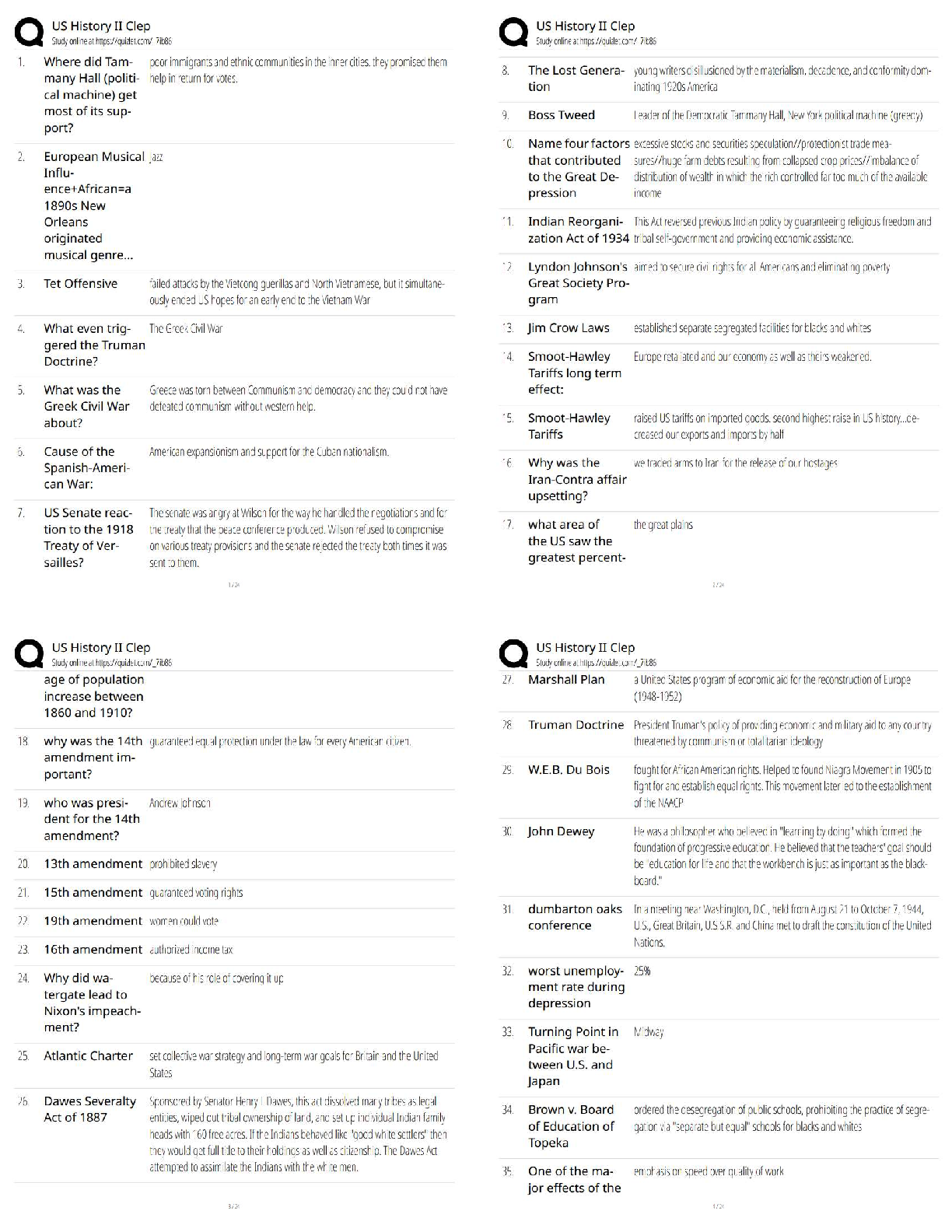*NURSING > QUESTIONS & ANSWERS > William Paterson University - NURSING 0405. Final Exam. All questions and Answers Explained (All)
William Paterson University - NURSING 0405. Final Exam. All questions and Answers Explained
Document Content and Description Below
Question 1: (see full question) The nurse is caring for elderly patients in a long-term care facility. What age-related alteration should the nurse consider when planning care for these patients? ... ________________________________________ Question 2: (see full question) A home care nurse is visiting a client with renal failure who is on fluid restriction. The client tells the nurse, "I get thirsty very often. What might help?" What would the nurse include as a suggestion for this client? ________________________________________ Question 3: (see full question) When educating a client about foods that affect fluid balance, the nurse would advise the client to decrease: ________________________________________ Question 4: (see full question) A nurse monitoring a client's IV infusion auscultates the client's lung sounds and finds crackles in the bases of lungs that were previously clear. What would be the appropriate intervention in this situation? ________________________________________ Question 5: (see full question) Upon assessment of a client's peripheral intravenous site, the nurse notices the area is red and warm. The client complains of pain when the nurse gently palpates the area. These signs and symptoms indicative of what? ________________________________________ Question 6: (see full question) A client with a diagnosis of colon cancer has opted for a treatment plan that will include several rounds of chemotherapy. What vascular access device is most likely to meet this client's needs? A peripheral venous catheter inserted to the antecubital fossa ________________________________________ Question 7: (see full question) Which client has more extracellular fluid? ________________________________________ Question 8: (see full question) A nurse is assessing for the presence of edema in a client who is confined to bed and who often lies supine. The nurse would pay particular attention to which area? ________________________________________ Question 9: (see full question) What is the rate of administration for packed red blood cells? ________________________________________ Question 10: (see full question) A woman age 58 years is suffering from food poisoning after eating at a local restaurant. She has had nausea, vomiting, and diarrhea for the past 12 hours. Her blood pressure is 88/50 and she is diaphoretic. She requires: Correct ________________________________________ Question 2: (see full question) A client is taking a diuretic such as furosemide. When implementing client education, what information should be included? ________________________________________ Question 3: (see full question) A decrease in arterial blood pressure will result in the release of: ________________________________________ Question 4: (see full question) Which is a common anion? ________________________________________ Question 5: (see full question) The oncoming nurse is assigned to the following clients. Which client should the nurse assess first? You selected: a newly admitted 88-year-old with a 2-day history of vomiting and loose stools ________________________________________ Question 6: (see full question) Which nursing diagnosis would the nurse make based on the effects of fluid and electrolyte imbalance on human functioning? ________________________________________ Question 7: (see full question) A physician orders an infusion of 250 mL of NS in 100 minutes. The set is 20 gtt/mL. What is the flow rate? ________________________________________ Question 8: (see full question) Potassium is needed for neural, muscle, and: ________________________________________ Question 9: (see full question) An intravenous hypertonic solution containing dextrose, proteins, vitamins, and minerals is known as ________________________________________ Question 10: (see full question) The nurse is instructing a young woman on her dietary needs for calcium in the prevention of osteoporosis. What food supplies the greatest amount of calcium? You selected: Cheese Correct Question 1: (see full question) A client with a diagnosis of colon cancer has opted for a treatment plan that will include several rounds of chemotherapy. What vascular access device is most likely to meet this client's needs? ________________________________________ Question 2: (see full question) A nurse who has diagnosed a client as having “fluid volume excess” related to compromised regulatory mechanism (kidneys) may have been alerted by what symptom? ________________________________________ Question 3: (see full question) The primary extracellular electrolytes are: ________________________________________ Question 4: (see full question) A client age 80 years, who takes diuretics for management of hypertension, informs the nurse that she takes laxatives daily to promote bowel movements. The nurse assesses the client for possible symptoms of: ________________________________________ Question 5: (see full question) A nurse is required to initiate IV therapy for a client. Which of the following should the nurse consider before starting the IV? Reference: ________________________________________ Question 6: (see full question) A 50-year-old client with hypertension is being treated with a diuretic. The client reports muscle weakness and falls easily. The nurse should assess which electrolyte? ________________________________________ Question 7: (see full question) What food would the nurse provide for a client who has hypokalemia? ________________________________________ Question 8: (see full question) A client's most recent blood work indicates a K+ level of 7.2 mEq/L, a finding that constitutes hyperkalemia. For what signs and symptoms should the nurse vigilantly monitor? ________________________________________ Question 9: (see full question) Potassium is essential for normal cardiac, neural, and muscle function and contractility of all muscles. Which is false about potassium? ________________________________________ Question 10: (see full question) The nurse is caring for elderly patients in a long-term care facility. What age-related alteration should the nurse consider when planning care for these patients? You selected: Cardiac volume intolerance Correct A physician has asked the nurse to use microdrip tubing to administer a prescribed dosage of IV solution to a client. What is the standard drop factor of microdrip tubing? 60 drops/mL ________________________________________ Question 2: (see full question) Which fluid should be administered slowly to prevent circulatory overload? ________________________________________ Question 3: (see full question) A nurse is measuring the intake and output of a client who is dehydrated. What is the average adult daily fluid intake in milliliters that the nurse would use as a comparison? ________________________________________ Question 4: (see full question) What is the lab test commonly used in the assessment and treatment of acid–base balance? ________________________________________ Question 5: (see full question) The nurse's morning assessment of a client who has a history of heart failure reveals the presence of 2+ pitting edema in the client's ankles and feet bilaterally. This assessment finding is suggestive of: Reference: Taylor, C., et al. Fundamentals of Nursing, 8th ed. Philadelphia: Wolters Kluwer Health/Lippincott Williams & Wilkins; 2015, p. 1493. ________________________________________ Question 6: (see full question) A nurse is measuring intake and output for a patient who has congestive heart failure. What does not need to be recorded? ________________________________________ Question 7: (see full question) A healthy client eats a regular, balanced diet and drinks 3,000 mL of liquids during a 24-hour period. In evaluating this client’s urine output for the same 24-hour period, the nurse realizes that it should total approximately how many mL? ________________________________________ Question 8: (see full question) The nurse is instructed by the physician that the client needs an intravenous fluid that is not likely to pull fluids into the vascular space. The nurse recognizes that the physician is suggesting which kind of fluid? Explanation: A hypotonic solution has a lower osmolarity than plasma; therefore, fluid would move out of the intravascular space rather than pulling fluids from the tissues into the vascular sp ... (more) ________________________________________ Question 9: (see full question) What nursing interventions would be appropriate for a patient diagnosed with deficient fluid volume? (Select all that apply.) You selected: • Intravenous therapy • Electrolyte management • Nutrition management ________________________________________ Question 10: (see full question) A patient with type AB blood has experienced a precipitous drop in his hemoglobin levels due to a gastrointestinal bleed and now requires a blood transfusion. Which of the following blood types may this patient safely receive? Select all that apply. You selected: • A • AB • B • O Reference: Taylor, C.R. Fundamentals of Nursing, 8th ed. Philadelphia: Wolters Kluwer Health/Lippincott Williams & Wilkins, 2015, Chapter 39: Fluid, Electrolyte, and Acid-Base Balance, p. 1477 ________________________________________ Question 2: (see full question) Which client has more extracellular fluid? ________________________________________ Question 3: (see full question) What is the rate of administration for packed red blood cells? You selected: 1 unit over 2 to 3 hours, no longer than 4 hours Correct Explanation: Packed red blood cells are administered 1 unit over 2 to 3 hours for no longer than 4 hours. Answer A describes platelets, answer C represents cryoprecipitate, and answer D describ ... (more) ________________________________________ Question 4: (see full question) Potassium is essential for normal cardiac, neural, and muscle function and contractility of all muscles. Which is false about potassium? ________________________________________ ________________________________________ Question 6: (see full question) Sodium is the most abundant cation in the extracellular fluid. Which is true regarding sodium? ________________________________________ Question 7: (see full question) When caring for a client who is on intravenous therapy, the nurse observes that the client has developed redness, warmth, and discomfort along the vein. Which of the following interventions should the nurse perform for this complication? ________________________________________ Question 8: (see full question) Major control over the extracellular concentration of potassium within the human body is exerted by: ________________________________________ Question 9: (see full question) A nurse who has diagnosed a client as having “fluid volume excess” related to compromised regulatory mechanism (kidneys) may have been alerted by what symptom? ________________________________________ Question 10: (see full question) A client with dehydration will have an increase in: You selected: aldosterone Correct Question 1: (see full question) A nurse is caring for a client who is on total parenteral nutrition (TPN). Which of the following clients are candidates for TPN? Select all that apply. ________________________________________ Question 2: (see full question) The nurse is caring for a client who had a parathyroidectomy. Upon evaluation of the client's laboratory studies, the nurse would expect to see imbalances in which electrolytes related to the removal of the parathyroid gland? You selected: potassium and chloride Incorrect ________________________________________ Question 3: (see full question) A nurse is measuring intake and output for a patient who has congestive heart failure. What does not need to be recorded? ________________________________________ Question 4: (see full question) Which is a common anion? You selected: Chloride Correct Explanation: Chloride is a common anion, which is a negatively charged ion. Magnesium, potassium, and calcium are cations, or positively charged ions. ________________________________________ Question 5: (see full question) Which statement most accurately describes the process of osmosis? ________________________________________ Question 6: (see full question) Which solution is a crystalloid solution that has the same osmotic pressure as that found within the cells of the body and is used to expand the intravascular volume? ________________________________________ Question 7: (see full question) A young man has developed gastric esophageal reflux disease. He is treating it with antacids. Which acid-base imbalance is he at risk for developing? ________________________________________ Question 8: (see full question) A client is taking a diuretic such as furosemide. When implementing client education, what information should be included? ________________________________________ Question 9: (see full question) Arterial blood gases reveal that a client's pH is 7.20. What physiologic process will contribute to a restoration of correct acid-base balance? You selected: increased respiratory rate ________________________________________ Question 10: (see full question) When an older adult client receiving a blood transfusion presents with an elevated blood pressure, distended neck veins, and shortness of breath, the client is most likely experiencing: Correct ________________________________________ Question 2: (see full question) An infant is brought to the emergency room with dehydration due to vomiting. After several failed attempts to start an IV, the nurse observes a scalp vein. When accessing the scalp vein, the nurse should use a(an) ________________________________________ Question 3: (see full question) Because metabolism continually produces acids, maintenance of pH within these incredibly narrow limits depends on two processes: buffering and compensation. Which statement describes a function of buffering? You selected: The kidneys influence the maintenance of the normal acid–base balance by changing the rate of excretion or retention of H+ and HCO3 ions. ________________________________________ Question 4: (see full question) Mr. Jones is admitted to the nurse's unit from the emergency department with a diagnosis of hypocalcemia. His laboratory results show a serum calcium level of 8.2 mg/dL. For what assessment findings will the nurse be looking? You selected: muscle weakness, fatigue, and constipation ________________________________________ Question 5: (see full question) A nurse is calculating the output of a client with renal failure and takes into account all modes of fluid loss. When addressing the client's insensible fluid loss, which amount would the nurse anticipate as the usual average? ________________________________________ Question 6: (see full question) A client with a diagnosis of colon cancer has opted for a treatment plan that will include several rounds of chemotherapy. What vascular access device is most likely to meet this client's needs? ________________________________________ Question 7: (see full question) Which client is at a greater risk for fluid volume deficit related to the loss of total body fluid and extracellular fluid? ________________________________________ Question 8: (see full question) The nurse writes a nursing diagnosis of “Fluid Volume: Excess.” for a client. What risk factor would the nurse assess in this client? ________________________________________ Question 9: (see full question) A nurse is assessing for the presence of edema in a client who is confined to bed and who often lies supine. The nurse would pay particular attention to which area? You selected: Sacral area Correct ________________________________________ Question 10: (see full question) During a blood transfusion, a patient displays signs of immediate onset facial flushing, fever, chills, headache, low back pain, and shock. Which transfusion reaction should the nurse suspect? You selected: Hemolytic transfusion reaction: incompatibility of blood product Correct ________________________________________ Question 2: (see full question) When the nurse reviews the client's laboratory reports revealing sodium, 140 mEq/L; potassium, 4.1 mEq/L; calcium 7.9 mg/dL, and magnesium 1.9 mg/dL; the nurse should notify the physician of the client's: ________________________________________ Question 3: (see full question) The nurse, along with a nursing student, is caring for Mrs. Roper, who was admitted with dehydration. The student asks the nurse where most of the body fluid is located. The nurse should answer with which fluid compartment? ________________________________________ Question 4: (see full question) A physician has asked the nurse to use microdrip tubing to administer a prescribed dosage of IV solution to a client. What is the standard drop factor of microdrip tubing? You selected: 60 drops/mL Correct ________________________________________ Question 5: (see full question) A dialysis unit nurse caring for a client with renal failure will expect the client to exhibit which fluid and electrolyte imbalances? Reference: Taylor, C., et al. Fundamentals of Nursing, 8th ed. Philadelphia: Wolters Kluwer Health/Lippincott Williams & Wilkins; 2015, pp. 1492, 1495. ________________________________________ Question 6: (see full question) During an assessment of an older adult client, the nurse notes an increase in pulse and respiration rates, and notes that the client has warm skin. The nurse also notes a decrease in the client's blood pressure. Which medical diagnosis may be responsible? ________________________________________ Question 7: (see full question) The nurse is caring for a client who had a parathyroidectomy. Upon evaluation of the client's laboratory studies, the nurse would expect to see imbalances in which electrolytes related to the removal of the parathyroid gland? ________________________________________ Question 8: (see full question) Which is not a primary intracellular electrolyte? ________________________________________ Question 9: (see full question) A client with renal disease requires IV fluids. It is important for the nurse to You selected: Administer the fluids through the dialysis access Incorrect ________________________________________ Question 10: (see full question) A group of nursing students is reviewing information about body fluid and locations. The students demonstrate understanding of the material when they identify which of the following as a function of intracellular fluid? ________________________________________ Question 2: (see full question) A client is diagnosed with metabolic acidosis. The nurse develops a plan of care for this client based on the understanding that the body compensates for this condition by: ________________________________________ Question 3: (see full question) Which of the following commonly used intravenous solutions is hypotonic? You selected: 5% dextrose in 0.45% NaCl Incorrect ________________________________________ Question 4: (see full question) Which client is at a greater risk for fluid volume deficit related to the loss of total body fluid and extracellular fluid? You selected: An infant age 4 months Correct ________________________________________ Question 5: (see full question) The nurse writes a nursing diagnosis of “Fluid Volume: Excess.” for a client. What risk factor would the nurse assess in this client? ________________________________________ Question 6: (see full question) Because metabolism continually produces acids, maintenance of pH within these incredibly narrow limits depends on two processes: buffering and compensation. Which statement describes a function of buffering? ________________________________________ Question 7: (see full question) Sodium is the most abundant cation in the extracellular fluid. Which is true regarding sodium? ________________________________________ Question 8: (see full question) Major control over the extracellular concentration of potassium within the human body is exerted by: You selected: aldosterone. ________________________________________ Question 9: (see full question) A client age 80 years, who takes diuretics for management of hypertension, informs the nurse that she takes laxatives daily to promote bowel movements. The nurse assesses the client for possible symptoms of: You selected: hypokalemia. Correct ________________________________________ Question 10: (see full question) Mr. Jones is admitted to the nurse's unit from the emergency department with a diagnosis of hypocalcemia. His laboratory results show a serum calcium level of 8.2 mg/dL. For what assessment findings will the nurse be looking? You selected: muscle cramping and tetany Incorrect Correct response: increase in fat cells. Reference: Taylor, C., et al. Fundamentals of Nursing, 8th ed. Philadelphia: Wolters Kluwer Health/Lippincott Williams & Wilkins; 2015, p. 1473. ________________________________________ Question 2: (see full question) A nurse needs to select a venipuncture site to administer a prescribed amount of IV fluid to a client. The nurse looks for a large vein when using a needle with a large gauge. Which of the following reasons explains the nurse's action? You selected: To prevent compromising circulation ________________________________________ Question 3: (see full question) Which statement most accurately describes the process of osmosis? You selected: Water moves from an area of lower solute concentration to an area of higher solute concentration. ________________________________________ Question 4: (see full question) After surgery, a client is on IV therapy for the next 4 days. How often should the nurse change the IV tubing for this client? You selected: Every 24 hours Incorrect ________________________________________ Question 5: (see full question) A young man has developed gastric esophageal reflux disease. He is treating it with antacids. Which acid-base imbalance is he at risk for developing? ________________________________________ Question 6: (see full question) The nurse is assessing a newly admitted client and finds that he has edema of his right ankle that is 2 mm and just perceptible. The nurse documents this at which grade? ________________________________________ Question 7: (see full question) The nurse is caring for a client with “hyperkalemia related to decreased renal excretion secondary to potassium-conserving diuretic therapy.” What is an appropriate expected outcome? ________________________________________ Question 8: (see full question) What nursing interventions would be appropriate for a patient diagnosed with deficient fluid volume? (Select all that apply.) ________________________________________ Question 9: (see full question) A nurse is required to initiate IV therapy for a client. Which of the following should the nurse consider before starting the IV? You selected: Ensure that the prescribed solution is clear and transparent. ________________________________________ Question 10: (see full question) A nurse is caring for a client who is on total parenteral nutrition (TPN). Which of the following clients are candidates for TPN? Select all that apply. • Clients with major trauma or burns • Clients with inflammatory bowel disease • Clients with liver and renal failure [Show More]
Last updated: 3 years ago
Preview 1 out of 39 pages

Buy this document to get the full access instantly
Instant Download Access after purchase
Buy NowInstant download
We Accept:

Reviews( 0 )
$12.00
Can't find what you want? Try our AI powered Search
Document information
Connected school, study & course
About the document
Uploaded On
Apr 24, 2020
Number of pages
39
Written in
All
Additional information
This document has been written for:
Uploaded
Apr 24, 2020
Downloads
0
Views
165






.png)
.png)
.png)
.png)
.png)
.png)
.png)
